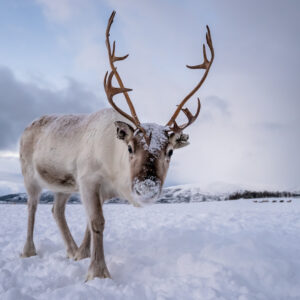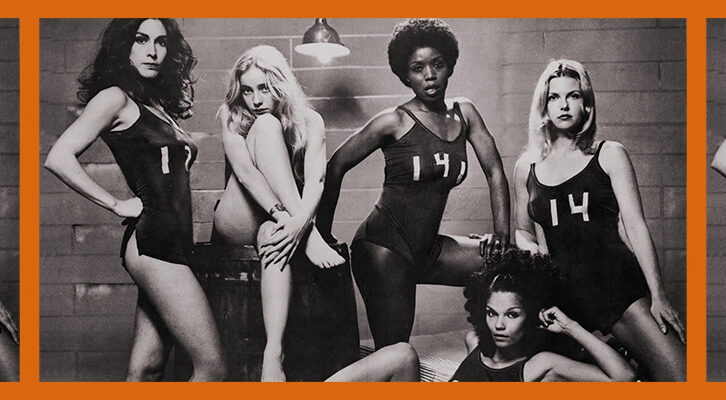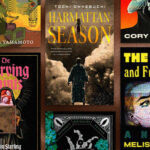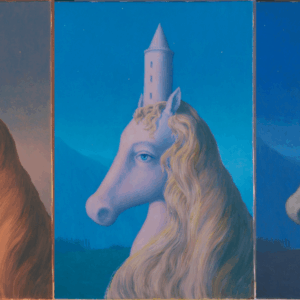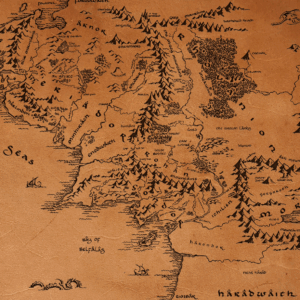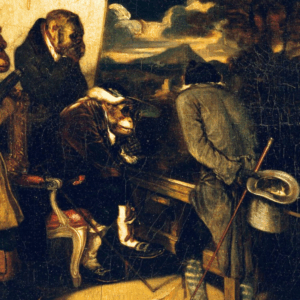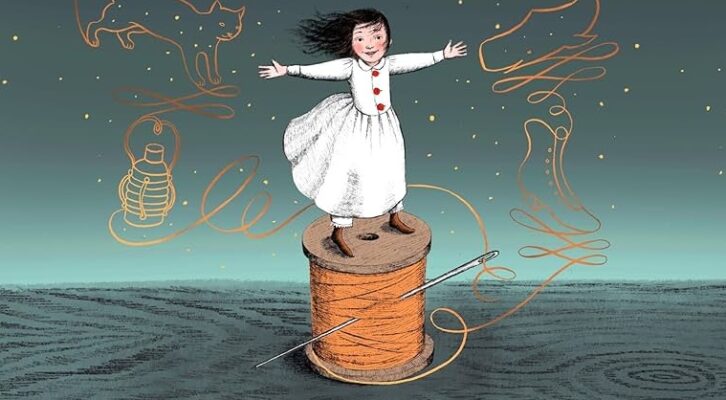
Kate DiCamillo on Telling Stories Within a Story and Capturing Wonder
Illustrator Sophie Blackall Talks to the Author of “Lost Evangeline”
Two-time Newbery Medalist Kate DiCamillo reunites with two-time Caldecott Medalist Sophie Blackall in an original fairy tale set in the world of Norendy, Lost Evangeline.
When a shoemaker discovers a tiny girl (as small as a mouse!) in his shop, he takes her in, names her Evangeline, and raises her as his own. The shoemaker’s wife, however, fears that Evangeline has bewitched her husband, so when an opportunity arises to rid herself of the girl, she takes it. Evangeline finds herself far from her adopted father and her home, a tiny girl lost in the wide world. The book is graced with exquisite black-and-white illustrations by Sophie Blackall.
Here, these repeat collaborators discuss their creative partnership and the joy of working together again.
*
Sophie Blackall: What did you love most when you were a kid, Kate? Do you ever write books for the child you once were?
Kate DiCamillo: What did I love most as a kid? There’s a question no one has ever asked me. I will now answer at exhaustive length: I loved books. I loved reading. I loved climbing trees. I loved laughing (and I laughed a lot and loudly). I loved sleepovers. I loved school. I loved games of every sort. And I loved animals of every sort. And like you, I loved tiny things. I was obsessed with The Borrowers. I collected miniatures of every sort. Oh, ha. I loved seashells, too. I had a collection of them. I would like, very much, to see the shell that was a door for another shell. (Also, it seems like there is a story there).
And yes, I write books for the child I once was and the child I still am. I am always looking for that magic, that hope, that belief that stories gave me as a child. I am also always looking at the floor boards, hoping to catch sight of a borrower running by. Is there a particular book that you read when you were a kid that keeps you looking for borrowers, metaphorically speaking?
But sometimes the thing remains elusive, and that’s even better in a way, because there’s magic in that shimmering thing. And we can spend our lives trying to recreate it.
SB: One of my favorites books in childhood (and still) is The Country Bunny and the Little Gold Shoes. Towards the end of the story, the brave and exhausted bunny is given one final herculean task, to deliver an Easter egg to a little boy who has been ill for a whole year, who lives in a cottage at the top of an ice-capped mountain. The glittering egg is described as having a beautiful snowy scene inside it, with people ice skating on a lake. I was surprised to revisit the book and find that there is no illustration of this scene, it is etched so vividly in my memory. It was not only the tiny-ness of the scene that appealed to me, or the world of ice and snow—that seemed so fantastic to me, never having seen either—but the idea of a whole world inside a world; a story within a story.
You are so good at telling us stories within stories, Kate. Would you talk a bit about that?
KD: Telling stories within stories taps right into that feeling of looking inside one thing (the egg) and seeing something else entirely. I didn’t grow up with the The Country Bunny and the Little Gold Shoes but I remember a book (that I have not been able to locate) of the view inside an Easter egg. And I keep trying to duplicate that feeling–of finding a world inside another world. The delight of that! The magic of it! It’s kind of a hidden-door feeling. When I’m writing, I’m sometimes (often) surprised at the story that is waiting hidden inside of the story that is already there. Does that happen with you when you draw and paint, that you discover a story within an image. I guess what I’m asking is does what your hand and eye produce sometimes surprise your mind?
SB: Yes! Yes! Yes! I love when I’m talking to you, Kate, and my thoughts go simultaneously left and right, like a river of thoughts branching off into streams, and I want to pursue all the streams, and hope they eventually spill into the sea. Here’s one of the streams: I am so interested in the memories we chase from childhood that we never quite catch—the book we can’t locate, or the slightly blurred picture that shimmers in our peripheral vision, or the elusive feeling of something. And sometimes a brilliant librarian will say, I know EXACTLY what you’re talking about, and put a book into our hands, and we’ll be catapulted back in time to the tree we were climbing when we read this long forgotten story. But sometimes the thing remains elusive, and that’s even better in a way, because there’s magic in that shimmering thing. And we can spend our lives trying to recreate it. Does this resonate at all with you?
The other stream is about our hands and eyes surprising our minds. This is the elusive thing I hope for when I’m drawing, a shy kind of magic you can’t look at too directly or it will vanish, and it’s often how I feel when I’m making pictures for stories you’ve written. I remember telling you about how that first tiny picture of the sloop in the cove, (the drawing that is on the frontispiece of Lost Evangeline) just appeared, unbidden. And it seemed to shimmer. A bobbing sloop on a shimmering sea. I don’t mean to suggest it’s always like this, that I draw in an iridescent trance. Often I am grunting and cursing and erasing.
The shimmering thing is a mix of wonder and remembrance and awe and magic and beauty and sadness and joy. All of my efforts to capture it fall short, but the great thing about what we do is that the need to keep trying never goes away.
It seems to me that your writing flows like a sparkling stream, Kate, but you also mentioned you carried Evangeline around for a long time. Was there any grunting and swearing when you carried her around?
KD: Yes, this was a story that I carried around with me for more than 15 years. I kept trying to tell it and it never quite worked. It wasn’t until I understood that Evangeline’s father was a shoemaker who loved the sea and longed for adventure, that the story finally found its voice.
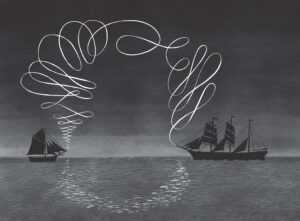
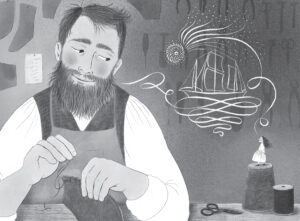
SB: I am thinking about how the shoemaker carries Evangeline’s tiny lantern for a long time, holding it aloft at sea, and I’m thinking about the beautiful, ambiguous ending of the story, and I’m wondering, how do you find the ending when you write, and how do you decide whether to wrap things up neatly, or leave them a little shimmery?
KD: Let’s start with the “shimmering thing,” that elusive thing that we are forever trying to capture and recreate–either a book that we read when we were a kid, a piece of art, or a feeling. The shimmering thing is a mix of wonder and remembrance and awe and magic and beauty and sadness and joy. All of my efforts to capture it fall short, but the great thing about what we do is that the need to keep trying never goes away.
Now, I will move on to the “grunting and cursing and erasing” that most often accompanies the attempt to capture the shimmering thing. Because, yes, that is usually how it goes. And that is how it went with Evangeline and her story. I knew that she was impossibly small. I knew that her name was Evangeline. I knew that she played a game called Lost Evangeline with family. I knew that she longed for the wide world. And (peculiar detail) I knew that there were blue curtains in the story. So: I would write a draft, certain of all of these elements and it did not work. I would sometimes write a second draft and see that it did not work. So there was much grumbling and erasing, and also despair. Because I knew the story wanted to be told and I couldn’t figure out how to do it. [Insert more grumbling here].
And then a dear friend gave me an old red lantern. And after that the shoemaker and the longing for the sea showed up, and I could at last tell the story. But you asked if I knew how it was going to end, and if I knew it would end ambiguously. I did not know how it would end (I never know how a story is going to end), all I knew was that the lantern had to come into it, and I worked toward its small, shimmery light.
I would like to ask you questions forever. But maybe we should leave it here: with this shimmering mystery of trying to make art.
__________________________________
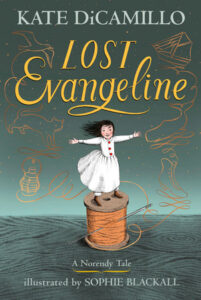
The Lost Evangeline by Kate DiCamillo is available from Candlewick Press, an imprint of Penguin Random House.
Sophie Blackall
Sophie Blackall has illustrated more than twenty books for children, including Big Red Lollipop, which was a New York Times Top Ten Picture Book, and the ongoing Ivy and Bean series, which has over a million copies in print. She won her first Randolph Caldecott Medal for illustrating Finding Winnie: The True Story of the World’s Most Famous Bear and her second for Hello Lighthouse. If You Come to Earth, her most recently published children’s book, has received wide acclaim. Her first book for adults was Missed Connections: Love, Lost and Found. She has created highly coveted limited edition holiday cards for the Museum of Modern Art, and her editorial illustrations have appeared in The New York Times, The Wall Street Journal, The Washington Post, Time, Gourmet, Food & Wine, Town & Country, and other publications.









